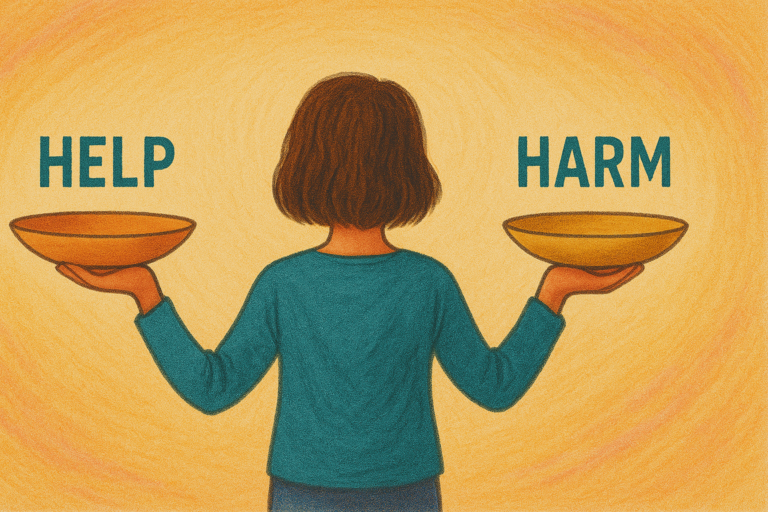Food, Flow, and the Fight to Feel Better
Tips for Navigating Chronic Illness for More Good Days than Bad

When you’re living with a chronic illness, it’s easy to feel like your body is no longer yours. I know this myself. Symptoms flare without warning. Energy vanishes midday. Plans get canceled. So when something is within your control — like what you eat or how you start your morning — it’s more than a routine. It’s a lifeline.
No peer-reviewed studies are proving that a healthy diet can cure my chronic illnesses, the party bus of autoimmune conditions. But there’s a mountain of evidence that diet can help, especially when it comes to inflammation, energy regulation, and gut health. In fact, a recent study notes that immune-mediated diseases are significantly more common in Westernized countries, where “transition nutrition” has shifted us away from traditional diets toward processed, inflammatory foods (study link).
So if there’s so much evidence about gut health and better disease control, why aren’t there more definitive studies? A recent review offered some clarity: understanding the crosstalk between nutrition and immunity requires coordinated interdisciplinary actions. Which means the scientific community faces challenges in funding and executing long-term, controlled nutritional studies. But that doesn’t mean you have to wait for science to begin experimenting.
Conduct your own research
Try eliminating the one thing you don’t want to go without, but suspect might be triggering your symptoms. Common culprits? Alcohol, meat products, and especially dairy, particularly cheese.
Yes, cheese.
Our collective attachment to cheese is so strong that there are entire studies and books about it. Dr. Neal Barnard, author of The Cheese Trap, argues that cheese may be surprisingly addictive due to its high salt and fat content, combined with the presence of casomorphins — opioid-like compounds that bind to the same brain receptors as heroin and morphine. While the effect isn’t as intense as narcotics, it’s enough to create cravings and make cheese notoriously hard to give up.
My personal experiment
In 2016, I attended a vegan cruise with my husband — a popular event for medical professionals and plant-based enthusiasts, featuring thought leaders like Dr. Michael Greger, Dr. Barnard, Dr. Esselstyn, Dr. Joel Fuhrman, and others. My husband had already gone fully plant-based after his quadruple bypass, successfully avoiding statins and other medications. I was mostly plant-based too but still indulged in dairy — especially when traveling for work.
At the time, I was also facing a serious health issue. I was growing a mass in my uterus, and my gynecologist was recommending a hysterectomy. Though still precancerous, the mass was dangerous.
The first lecture we attended on the cruise was given by Dr. Barnard. He spoke directly about the link between dairy and women’s health, citing compelling evidence of how many women found relief from issues after going dairy-free. I decided right then: I would try it. No cheating: no cream in my coffee, no cheese on my sandwich.
That was February 14th.
By my follow-up on October 5th of the same year, the mass had significantly reduced, almost negligible. I was relieved. And, I’ll admit, a little frustrated — because I really loved cheese. But for me, the evidence was now personal. I had watched my husband reverse a serious heart condition with food. And now I had seen my own body respond — dramatically — to removing dairy. The shift was undeniable. It was about the food.
And food, of course, is only part of the story.
Start with Meditation over Medication
Let’s talk about meditation and mindfulness. If you’re one of those people who says, “I can’t meditate — I can’t turn my brain off,” guess what? You don’t need to. Meditation isn’t about clearing your mind; it’s about changing your relationship to your thoughts.
These practices are about observing and managing thoughts, not suppressing them. The goal is to become more aware of your thoughts and feelings in the present moment, without judgment or getting swept away. It’s a skill that calms your nervous system, reduces stress, and — over time — can even shift your experience of pain.
I’ve used meditation for pain control for years. I’m not always medicine-free, but I often start with mindfulness to assess whether stress or anxiety might be amplifying my symptoms. Sometimes, that pause is enough to change the outcome.
And yes, the science backs this up. According to the Mayo Clinic, mindfulness exercises help people reframe how their brains interpret pain. One study by Fadel Zeidan, Ph.D., found that participants who practiced mindfulness showed less brain activation in regions that process pain. Some were even able to reduce or eliminate pain medications entirely through daily mindfulness (source).
Once you feel the effects of meditation, you might just become as addicted to it as cheese.
Get started with these gentle nudges
- Choose one area to experiment with this week — food, movement, or stress. What’s one manageable thing you can try?
- Don’t aim for perfection. Aim for consistency.
- Keep notes on what you notice. Patterns emerge over time.
This is part of my Navigating Chronic Illness series, which offers five small nudges to help you build agency and resilience, one step at a time. If you are new to this series, you can start at the beginning here. I hope some of these suggestions resonate with you and help you on your path to having more good days than bad.
If you’d like support along the way, I offer resilience coaching tailored for those living with chronic conditions. Book a free call using the menu link above.
~Julee Everett
Hone your craft, speak your truth, and show your thanks
Get support in your inbox through the email newsletter. Learn more about your resilience with the free resilience quiz!




